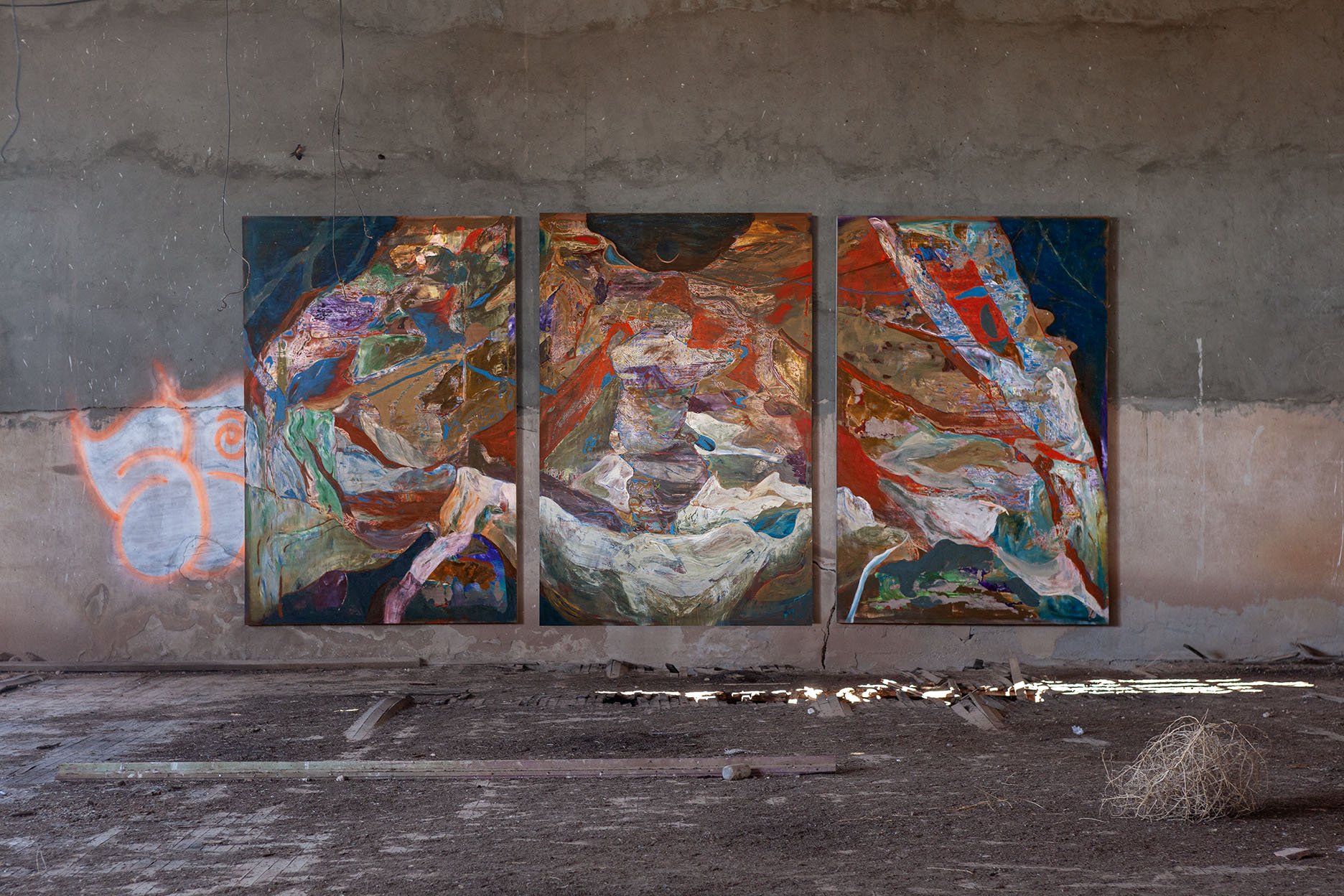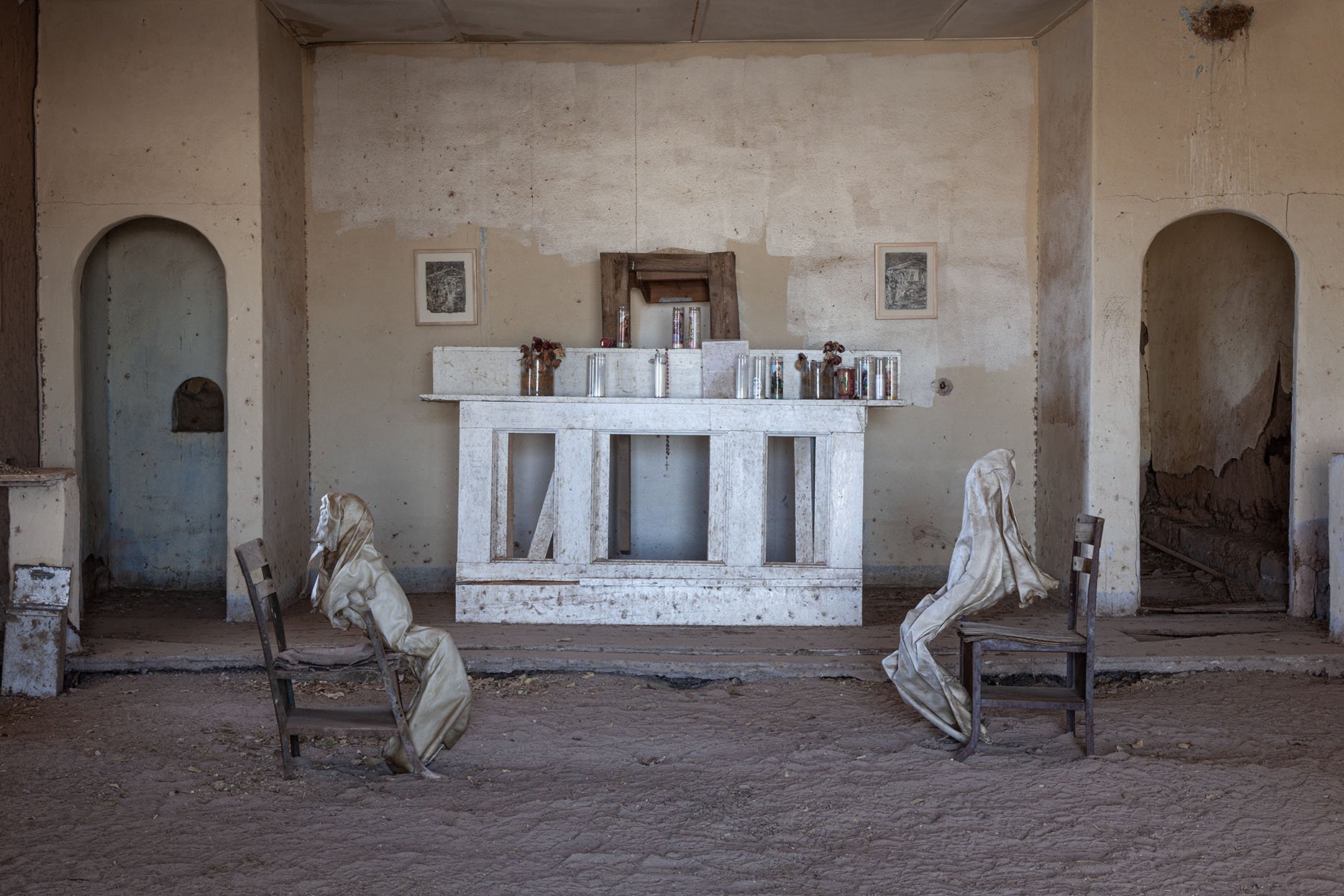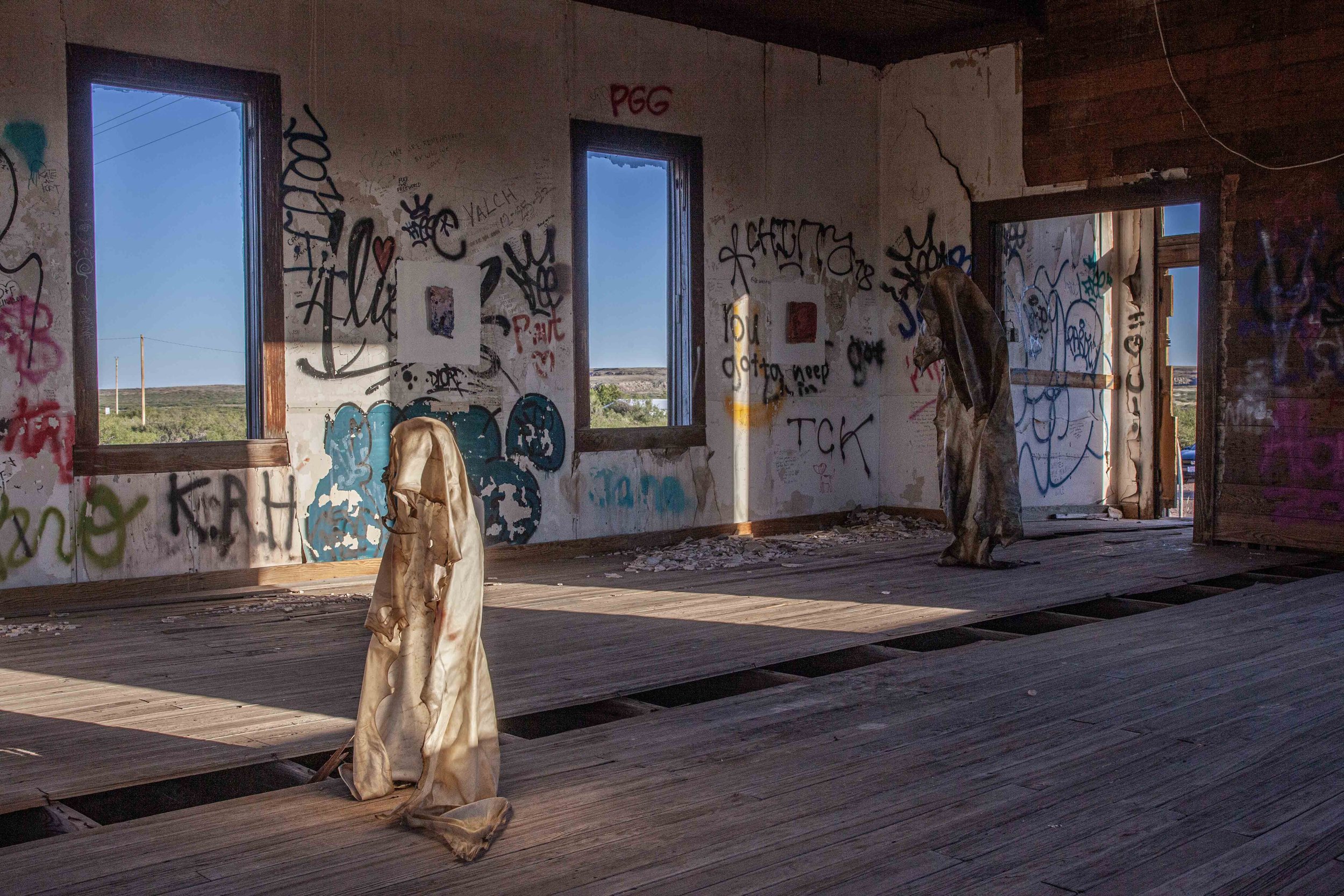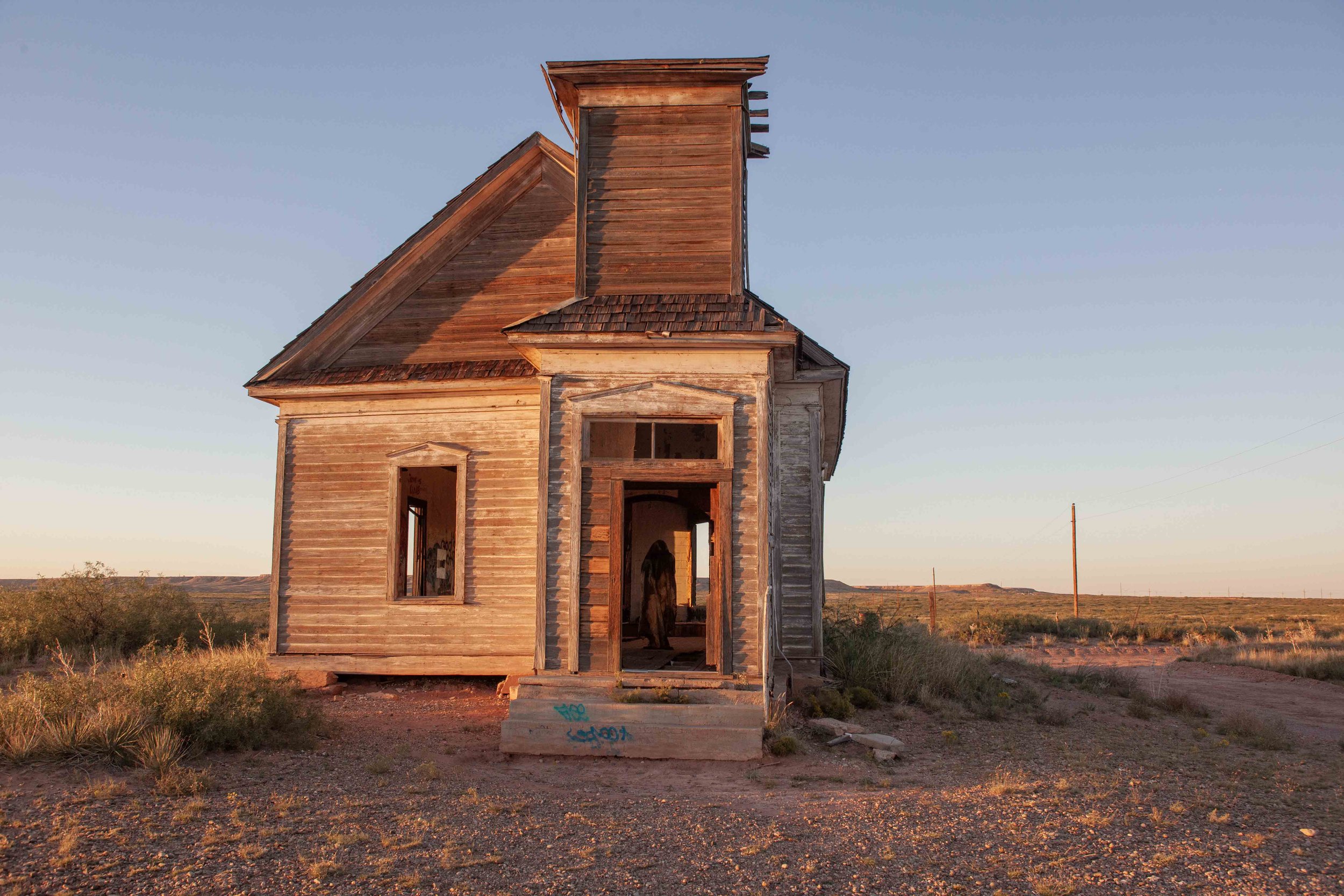Already Paradise
Archaic Brother | Installed in Abandoned Bible School at Fort Sumner, New Mexico
I would not speak of the mountain
Nor the moon in its water
Already paradise
Already the fool
If Nihil has succeeded, it’s because it’s finally failed.
Over the past year or so, I’ve grown aware that what had begun spontaneously and in earnest was turning into a performance, a kind of window dressing, or, gods forbid, a brand. Now, four years on, it’s apparent the Nihil project must end where it began, on a hot New Mexico summer day in the abandoned Cedarvale School.
The Tracker and the Tracked | Installed in Abandoned School at Cedarvale, New Mexico
At nearly 45, I’m standing at the top of a ladder, which itself is situated on a soft, drooping, rotten wooden floor, which could absolutely collapse at any second, and which absolutely has some ratio of rats to rattlesnakes living beneath it. I’m not the spry 40-year-old youngster I was when I came here more than four years ago. My partner-in-crime, the artist Samuel Staffan, is holding the ladder. I have one arm extended as far upward as I can reach, holding a very heavy unrolled 130 x 110-inch canvas, which I’m attempting to staple to the wooden cleat above, while bending ignorantly over the top rung of the ladder where my staple gun rests. It must appear to be happening in slow motion to Sam, who might be deciding whether he’ll dodge or catch me when I fall (it requires self-restraint not to ask which he’s decided on). My arm-span is at full reach, and proves to be just enough. I say aloud, “this is the last time. I’m not made for this shit anymore.”
Four years ago, while still living in Roswell, I packed a U-haul with paintings, drove three hours to this selfsame New Mexico ghost town, and installed them in the school. I did this in a time of loneliness and isolation in the midst of Covid, and in great anticipation of the imminent birth of our daughter, then just two months away. The experience had nearly killed me then as well, but happily so, cathartically so.
A Door in the Darkness | Installed in Abandoned Bible School at Fort Sumner, New Mexico
Nihil wasn’t yet a word occupying my mind, let alone a structure, practice, or set of principles. At that time, I wanted only to find out what I could accomplish on my own on a vast windswept landscape dotted with ruins. I’ve often called that first abandoned school install an “exhibition for ghosts,” or, truly, an “exhibition for resident barn owl.” In fact, the only piece I made specifically for the space was an overlarge barn owl portrait. The rest of the work was simply hanging around. I couldn’t have anticipated how enlivening the experience was, how strangely better I felt to have the space to myself rather than to have a real exhibition, however well attended. The seeming indifference of its emptiness was something akin to a religious experience. My estrangement from the culture began shifting from a kind of debilitating psychological complex to a sense of freedom and opportunity.
Almost twenty years as a working artist has been mostly lonely, confusing, and decidedly unglamorous. The most challenging aspect, for me, has been learning to cope with feelings of exclusion, humiliation, and of being misunderstood and overlooked. Though we came to New Mexico for a residency, it nevertheless felt like a final exile from fifteen manic years in San Francisco and Los Angeles.
What I didn’t yet know was that putting work in an abandoned school in the middle of nowhere was the first step in forming a contemplative practice or game that would facilitate a personal awakening of a most important kind. I experienced a deeper sense of trust in mystery and time, allowed that I might never find meaningful connection in the art world, and that, actually, it might not matter. The install had happened spontaneously, sincerely, and irrationally without any expectation of outside response or validation. From there, I developed the Nihil practice and installed in several more spaces like it: abandoned schools, churches, and a post office. Without being conscious of it, I was looking for the possibility of longterm continuance as an artist apart from the doings of the art world, and apparently assumed Nihil could go on forever. If Nihil is really “about” anything at all, it’s to do with forming a practice in the emptiness of life in lieu of answers that never come, answers for terribly fundamental questions. Why live? Why make anything? Why say anything? What is art for? Can anyone hear me, see me?
All of these questions are questions of meaning and identity. Yet only by asking them have I been able break from the shallower consolations we tend to deceive ourselves with and to allow for the depths of uncertainty for which only practice is an answer. Still, out of the inquiry came a collection of experiences, objects, and images which has amounted to a surprising sort of symbolic order. I can never say exactly what that order is, but I’ve felt it in the archetypal instances which have been revealed through travel, writing, and making paintings. Nihil (nothing) gave me something unexpected: meaning.
Book of Hours (Yeso, New Mexico, 1957) | Installed in Abandoned Post Office in Yeso, New Mexico
Yet, over time, little by little, I noticed a stubborn tendency, first in fleeting thoughts, and then more consciously, that I was intentionally trying to withhold specificity from the work. I wanted to maintain it (the individual works and the work overall) in a kind of blur, to resist naming. I believe this is a good strategy for painters, for a time. It’s useful in postponing judgments so that one can find oneself in strange new territory, the only way to make something truly interesting. But eventually, not naming shifts from asset to copout. Eventually, as Flannery O’Connor once wrote, “the thing would suddenly stand before him, strange and terrifying, demanding that he name it and name it justly and be judged for the name he gave it.”
Life has changed again. I was looking for reasons to stay alive, and now I have a very good one. I’m a happily exhausted middle-aged dad. I have an incredible four-year-old daughter whose creativity and intelligence, in many ways, has already surpassed my own. I’m married to Maja Ruznic, who I believe is the most talented painter of her generation. On a typical day, I have a million ordinary demands and responsibilities in my extraordinary ordinary life. At bottom, I’m a somewhat eccentric but mostly ordinary guy with occasional back and shoulder pain who avoids the dentist and drinks non-alcoholic beer. I carry ChatGPT around like a dog with a stick. Except it’s a stick that tosses itself. Another novelty to keep me interested in the world, to make me feel there are still continents to discover. I try to think about the yard occasionally and can’t get the irrigation timer to work.
The Hermit | Installed in Abandoned School in Cedarvale New Mexico
Four years ago, I installed paintings no one cared about in a part of the world few will ever know exists. Now I was installing a massive triptych in a gymnasium, while, unknown to me at the moment, one of my galleries was negotiating its sale to a museum I’ve never heard of in a country I’ve never visited. It’s as if, like some kind of desert hermit, I’ve invisibly occupied an unknown land, wrestling with obscure gods and phantoms, until, finally, knowing nothing at all anymore, and desiring none of my old grievances, am obliged to stand up, dust myself off, notice that the world has changed, and that I’ve changed with it. I recall that the first tenet of Nihil is “Exile and Absence.” But what began as exile has welcomed me home; what was absent is now all too abundant. The narrative of loss served me miserably well for too long, and now I must dress for dinner where my attendance is expected.
As I wrap up this project, I am reflecting on what I’ve learned and where I’m headed from here. I am thinking about the desperate state in which I began Nihil, the way in which I came to view communication with an audience or public as a hopeless prospect. I had wanted to replace issues and topics, as a method for formulating a subject, with structures and principles. I wanted to remove meaning and narrative from the equation as a means of uncovering whether either was necessary, and, if they were, where else they might emerge apart from my own preoccupations. “Non-meaning” was another of the Nihil principles, which is to say, premeditated meaning was against the rules in creating a Nihil artwork. If the making of images was to come from direct experience along the Nihil route, then I didn’t have to be responsible for what it all meant. In some basic sense, I just wanted to know what it would feel like to remove the burden of meaning from image and object making. But really, I wanted to know if I could live without meaning, since it hurt so badly to feel my own life was meaningless.
What I found was a kind of non-dual outlook on the question. Nihil seemed to bring about the right conditions for instances of synchronicity. In the early stages of the project, catharsis, ecstatic experience, and an overall process of emptying seemed to lead the way to identifying patterns I perceived as inherent to the world around me. It was an important part of Nihil, but also of what I’ve called “repatriation,” my “soul remembering the soul.” Gradually, ego identification wasn’t my only identity, and a sense of self, as an improved attentiveness to the world, grew up from out of the world. I might never have experienced as deep a sense of awe and mystery in daily life as I have since Nihil. It’s important to explain here that when I refer to Nihil, I’m referring to an overarching practice, in addition to making paintings, which includes roaming exploration, meditation, and, often, if only briefly, a manner of connecting with strangers.
In the worn-out dichotomy of whether meaning is something which humans project onto a meaningless world or whether the universe really is inherently meaningful because of God, gods, or some kind of sacred design, it seems to me that, either way, each layer of explanation begs another question, and an infinite regress begins. As usual, we’re stuck in language.
The Summer Triangle | Installed in Abandoned Church near Las Vegas, New Mexico
I know that while I sometimes experience synchronicity, I am also a good recognizer (or projector) of patterns, and that, in some sense, deriving meaning from the world is to recognize patterns in it. I’m subject to all the same tendencies as all other humans: confirmation bias (I notice what I already believe is true), psychological priming (I notice things I’m already thinking about), retrospective coherence (things take on specific meaning in hindsight), and selective attention (I don’t notice what breaks from the pattern). Yet, though we can give names to psychological eccentricities (e.g. apophenia) and logical falacies (e.g. infinite regress), all abstract concepts, I would argue, are themselves begging the question, are themselves a just another turtle in a never-ending stack of turtles to “explain away” the kinds of embarrassing uncertainties we fear might leave us overexposed should we not put a cork in the bottle at an early convenience.
I take the trouble to list several factors that inconvenience the concept of synchronicity because, while I do value it greatly, Nihil also seemed to make me more aware of how I tend to observe even as I observe. The world, as I know it, is, in no small part, my own projection. If my desire for a more romantic reality is so often propped up by my obscurant pseudo-poetry and good-enough-for-now, temporary, out-of-context beliefs about what the world is and what I am to it, I must still ask what makes me this way. How desperate it is to be human. And yet is there any starker requirement than desperation to make a genuine discovery?
The Hermit | Installed in Abandoned School in Cedarvale New Mexico
Nowadays, I know where to find what I need, and this is at Nihil’s peril. For example, I had several visualizations, dreams, and, in one holotropic breathwork session, a powerful physical sensation of encountering and merging with a mountain lion. In the snowy Sandia Mountains, I had tracked one a short distance before sanely turning back. When I wanted to draw one, I didn’t try to find it in the wild or turn away from the idea altogether; I went to the Albuquerque zoo where I drew imprisoned cats of all kinds, including lions and tigers. The zoo is on the Nihil route, and so it’s permissible to go there and draw animals. But though it’s permissible, it happened because an emerging sort of narrative or meaning preceded the excursion.
This is how it is that Nihil’s success is its failure. In removing the kinds of meaning I was preoccupied with before beginning on the project, it made room for meaning to, as it were, pop up in the outside world, a product of where my unconscious meets the world in unexpected ways. Though I do unavoidably project onto the world, it seems, for its part, all too happy to oblige.
I would argue that there is no world in which we don’t find meaning. That isn’t our trouble. Our trouble is that although we find meaning everywhere we look, we aren’t consoled by it for long or at all times. We’re no less lonely or desperate just because we’re capable of pattern recognition. We perceive something miraculous in the world, yet when we want to share it with someone, they might say, “What? That old thing?” We know meaning, we just don’t know the meaning of meaning.
For a time, meaning and identity gives us the illusion of a ground to stand on, but given any direct attention at all, or any shift in perspective, soon the ground collapses under scrutiny. Though the recognition of a groundless existence is terrifying for most of us, it’s a productive realm for the artist. In that groundlessness is the seed of art’s better purposes. If making art is a form of inquiry into reality, then making work in a groundless world is to call attention to the impermanence of everything, including ourselves, and to learn to accept that fact if for no other reason than its usefulness. To what end? We can’t know. If we did know, we’d probably refuse to do it.
Moon in Water | Installation in Abandon Church in San Acacia, New Mexico
Nihil never was going to last forever. Yet its extinction seems to be its survival. If Nihil was the game that paved the way to move forward in my groundless existence, and to offer a kind of nascent archetypal order, then it was the game that makes all future games possible. For it might just be that the only way forward for me is to play in that zone between ultimate meaning and ultimate meaninglessness, and to devise a method by which to roam. To be honest, it’s not really only Nihil which has made this possible, but everything that’s happened in the outside world over the past few years. I no longer have a conscious ideological belief about the world. I don’t know what to hope for or what to resist. There are no more politics that can be believed. All dichotomies, for me, have failed, and that includes something like a Left and Right. Nihil didn’t show this to me, but it worked so well because it was non-dual in practice. I could rest easy in ambiguity, trusting it would eventually prove itself specific in its presence, even ineffably so, in the objects and paintings that resulted.
Autumn Pilgrimage | Installed in Abandoned Church in Tiaban, New Mexico
The truth about the second and final install at the Cedarvale School is that we drove the two hours there and unpacked the work and tools on two consecutive days. On the first day, I neglected to pack any masonry tools. There was simply no way of getting through the concrete walls. We lugubriously packed up and trudged home. On both days it was a hundred degrees. Overlarge crow chicks squawked and shrieked in a collapsing nest in the rafters above, as their mother flew in, from time to time, to bring them food and scream at Sam and me. The floor was covered in rat shit and the walls speckled in swallow droppings. It smelled like a toilet farm. Where was the romance I remembered? Where was the barn owl? Where was the warm company of ghosts with whom I once danced? I love Sam, but how had this turned into a production I do with team members? Another partner in crime, Lana Scholtz, had joined me another time. Before her, Julia Jameson. Sam’s made a series of films now. I share all this on Instagram regularly, and will again. I exhibit the work internationally and sell it too. If once I was poor enough that I was willing to cobble scraps of canvas and burlap together to make something large enough to work on, now I buy all that stuff, and I pay everyone mentioned to help me.
Sometimes I forget the underdog narrative has become a lie. Somewhere inside, I’m still the same narcissistic, insecure, delusional, needy, desperate over-sharer I’ve always been, but now I’m condemned to be aware of it. It’s funny and tragic to openly confess that my parents never took an interest in what I do, but once you know that, all the behaviors are obvious. Take a moment to laugh! I am, even as I type!
I Would Not Speak of the Mountain (Vesuvius) | Installed in Abandon School in San Antonio New Mexico
What’s funniest and saddest about that fact is truly right at the heart of the matter. It’s my belief that if my brother hadn’t died under such especially awful circumstances, my parents would have been more present. I have a daughter, but I don’t have multiple kids. When one dies, and you, as the parent, are expected to go on as before, for the sake of the surviving kids, how do you move forward and provide a safe functioning environment for them if not for a high dose of repressiveness creeping in at all times? It’s a hallmark of having children that we look back at our own parents and realize they had just as little clue as to what they were doing as we do in our own lives.
The first archetype to make itself known in the Nihil project was what I called the “Archaic Brother.” This was directly to do with the first tenet, “Exile and Absence.” I wrote, at that time, that exile was not only to do with being forced out of California, but, in some sense being forced from my own memory of my childhood. I felt that absence of memory as a presence and found it everywhere I went. I felt it for as long as I needed to. Now? Never.
Out of Existence XXIV (for Lucas) | Installed in Abandoned Bible School at Fort Sumner, New Mexico
This is a rather long piece of writing to arrive to such a simple and rather unsophisticated observation. Nihil was an accidental work of self-help. It was and is art as therapy. Yet, in all my tired-ass sentimental dad-ness, I can’t figure out what else it should even be for. Nihil, if you don’t mind my saying, was fucking brilliant. I put my trauma at the center of it, made it the anima mundi of my ritual, the viewing lens through which all observation was made, exteriorized my own unconscious projections, accidentally invented numerous new archetypes by which numerous valences could be transferred and exchanged, and by doing so, gave closure to a ghost which had haunted me all my life. And I did it all by accident. The sheer, unyielding force of the unconscious brings me to the edge of my sanity. And yet, even now, as I feel the truth of this all over my body, it’s one of those things I could hold up to someone and hear them say, “What? That old thing?” And yet?
And yet I still think there might be no other reason to make art than to integrate it in one’s own life in a way that brings meaning and purpose and love into it, even if, or especially if, it defies explanation.
So this is how the story ends: I fly my studio manager out to New Mexico where I live so that he can make a short film about Nihil, drag his ass out into the hot barren desert to a rat-infested shell of what was once a school, grumble and complain about two arduous days of hard work, and, although thanking the space when I leave, I vow never to return. Nihil is over.
That I get to bitch is my reward. Whatever I was supposed to have achieved in Nihil, whatever ghost I was meant to exorcise, somehow, without quite noticing, I did. There are no ghosts there anymore, at least none of mine. I get to move on. The practice was integrated and now the need is liberated. From playing a game I invented by accident, I learned how the game works, and because I understand it, I can design new ones. I can make the pieces and the board. I can set the rules and extrapolate endless sequences and combinations. And the world outside has been keeping busy. Something bizarre and technological has grown and multiplied since 2020. Some call it our doom, others our salvation. In either case it’s a wager, and, anyway, when hasn’t technology been both?
It’s time to come out of the desert. There are new games to play.
Autumn Pilgrimage | Installed in Abandoned Church in Tiaban, New Mexico











